
The following instructions (and pictures) will allow you to create .58 caliber cartridges
that, while not exact, are
closer in appearance to Civil War cartridges than cartridges made from
most styles of pre-rolled tubes.
At no point, during a reenactment, should any wadding or paper be placed in the barrel of your weapon!
Required materials (photo 1) include a former, paper, thread, and wadding (not shown).
In the instructions the
former used is made from a piece of .5 inch dowelling. One end is shaped to
resemble the mini-ball. Around
the dowel I wrapped one layer of 20 mil (.02 inch) pipe tape and one
layer of common package wrapping tape.
This brought the former to approximately .56 caliber. Note
that one end of the tape is about 1/2 inch from the
flat end of the former. This acts as a guide when
the rolled cartridge is tied.

Light weight craft or masking paper, usually sold in rolls, is a close approximation
(in color and weight) of the paper used in original cartridges. Newsprint, while not
as close a match, can also be used. The paper needs to be cut into the shape
of
a trapizoid with the following dimensions: A = 4 1/8 inchs; B = 4 inches; C = 2 1/2
inches.
Several types of
thread (cotton, crotchet, linen, etc.) can be used, linen being the
most appropriate. The following
link is for a 18/3 linen thread, appropriate for
cartridge making.
linen thread
Place the former (shaped end facing left) on the bottom edge of the trapizoid with the
tall side of the trapizoid
to the left (photo 2). Note that the right side of the paper matches up
with the edge of the tape on the former.
Roll the paper tightly around the former. Tie off the open
end of the tube about 1/3 to 1/2 inch down (photo 3).
Trim the thread, and while still on the former,
open, and flatten the tied end of the tube over the former (photo 4).

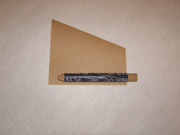

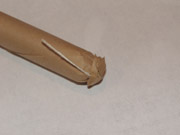
photo 1
photo 2
photo 3
photo 4
At this point add the wadding (cotton ball, folded toilet paper, etc.) and, using the
former, push it firmly into the
nose of the cartridge. This serves
two purposes. First is simulates the miniball, second it closes off the top of
the round, preventing
powder from leaking. Pour the measured powder into the tube and form the tail. First fold
over the top of the open tube (photo 5). Next, edge wise, fold the sides of the tail, into the
middle (photo 6).
Next fold the tail back over the cartridge and then fold the tail down the
side of the cartridge (both of these folds
should be sharply creased) (photo 7). If correctly
constructed there should be a diagonal "flap" on the tube. This
will allow you to tuck the tail (photo 8)
if you choose to do so.


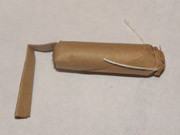

photo 5
photo 6
photo 7
photo 8
The following photos and text provides information on how to package cartridges into bundles (Arsenal Packs).
Items required for arsenal packs include a box to bundle the packs, ten completed
cartridges, a tube with 12
percussion caps, string, and paper. Shown in photo 9, the bundle box can be
a very simple item of two wood
uprights nailed to a board. The uprights should be at least the length
of your finished cartridges and at least
twice the diameter of your finished cartridges in height.
The two uprights need to be separated by five times
the diameter of the finished cartridges. Less
than five diameters, and the cartridges will not fit. Much more than
five diameters and it becomes
more difficult to produce arsenal packs with sharp edges.
The same paper used for the cartridges can be used for the bundles. The paper should be
cut in a rectangle, 6
or 7 inches on the short edge and 9 or 10 inches on the long. The tube for the
percussion caps should be made
from a spare cartridge trapizoid. The dowell used to roll the tubes for
the percussion caps needs to be a bit under
.45 inches. For my former I used a 7/16 dowell, wrapped
once with common, package wrapping tape. One end of
the percussion cap tube can be tied off and closed in
the same manner as a cartridge or simply twisted closed.
Insert
twelve percussion caps into the tube and then fold over and close the open end.
Place the string, paper, and ten cartridges into the box (photo 10). Note: the
paper's long length is marked A. Fold
over the top sides and then fold over one end - like wrapping a gift
(photo 11). Place the tube of cartridges in the
open end of the pack, fold and close the remaining end,
and tie off (photo 12). Tie the pack off in the long direction,
cut and trim excess string (optional) and
apply a label (also optional) (photo 13).
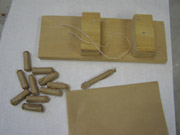

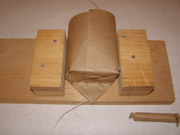
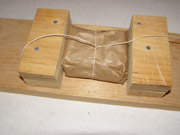
photo 9
photo 10
photo 11
photo 12
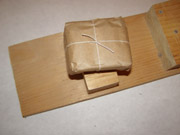
photo 13
Additional notes: Regulations call for the rounds, when placed in the pack, to alternate
tail to ball. The regulations, however, are not clear if rounds are to alternate within a single
row,
or
if the rows are to alternate. When making my packs I have chosen to alternate by
row. I have shown
this in photo 10 by using cartridges made with newsprint on the bottom
row, and made with craft paper on
the top row.